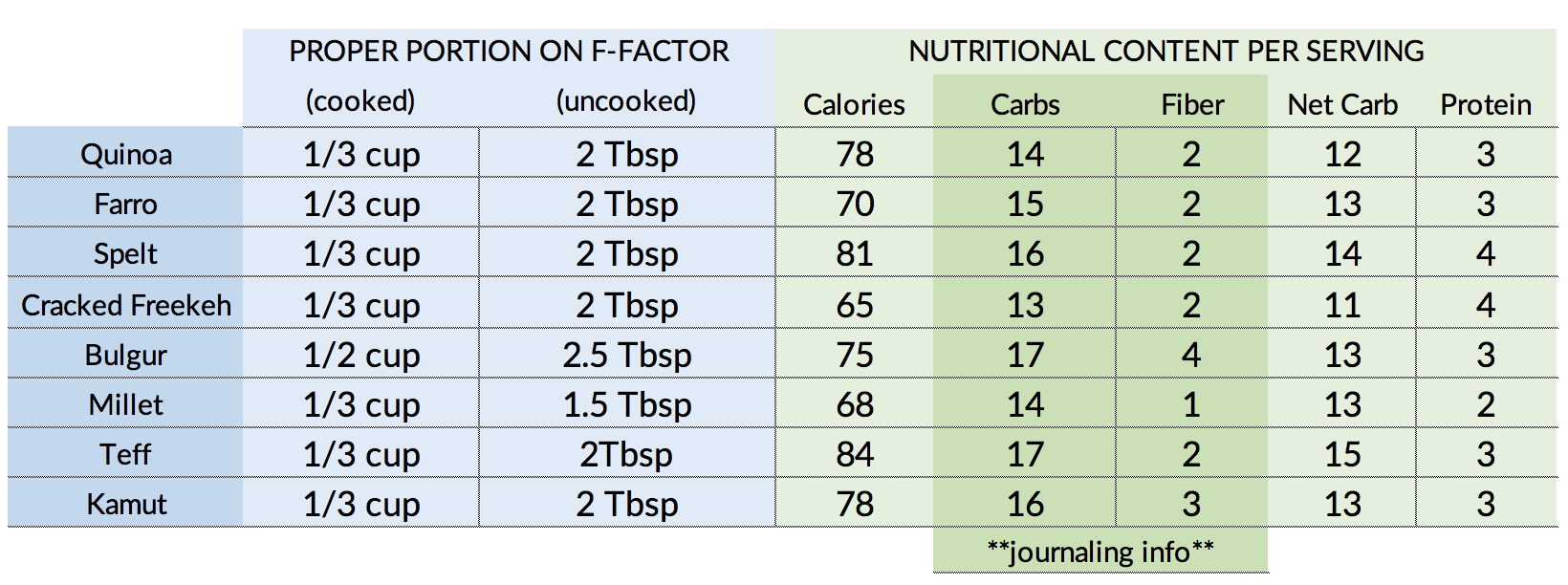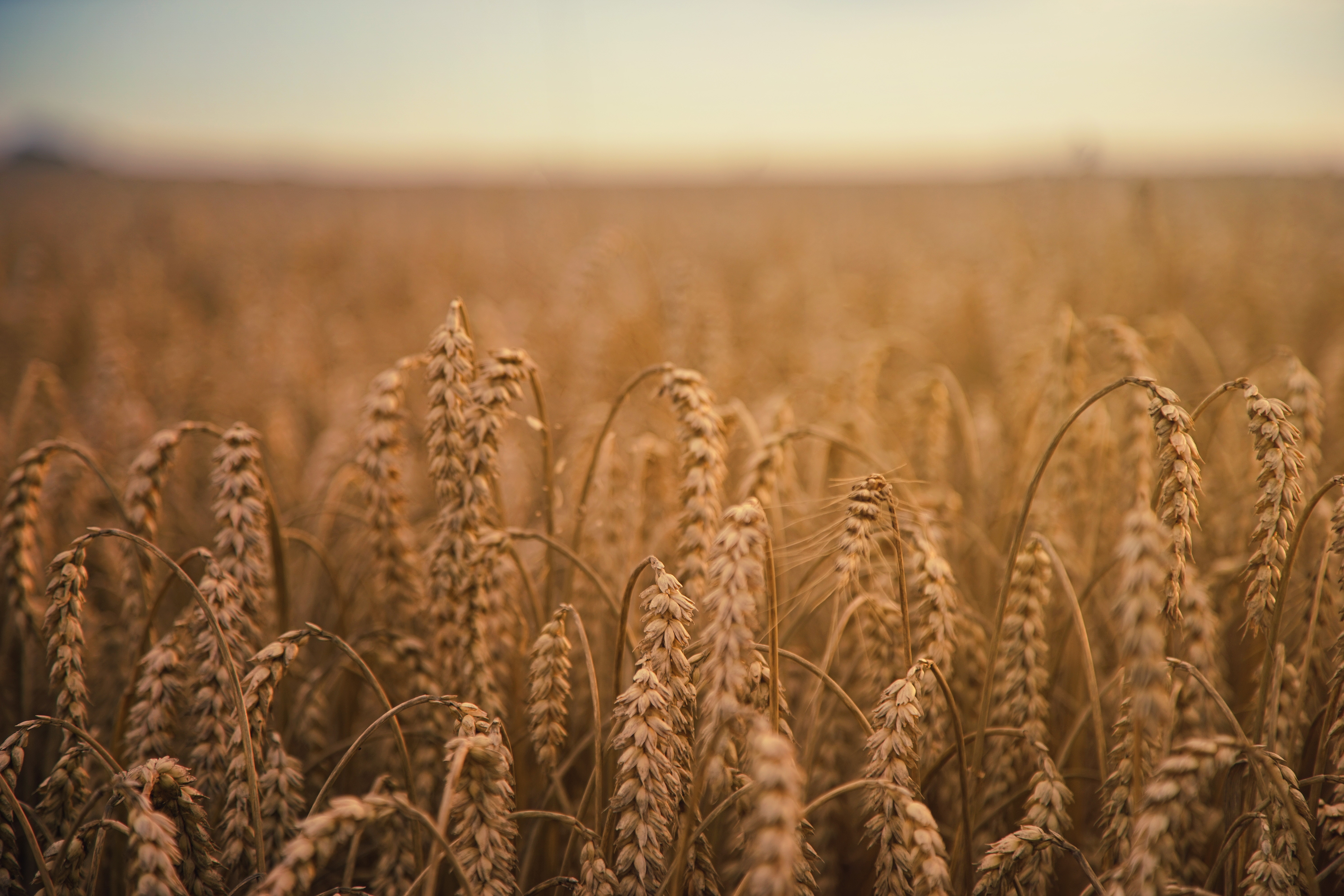You asked, we listened. Follower question of the week.
Q: What’s the deal with ancient grains? Aren’t they healthy? Can I have them on F-Factor?
A: Ancient grains, essentially, are a group of grains that have remained relatively unchanged over the last several hundred years, i.e. they have not been refined or altered from modernization. Quinoa, the most notable of the group, falls in this category, but you’ve likely heard of at least one or two others (bulgur, farro), because these carbs have become increasingly popular over the past few years.
The deal with ancient grains is that they’re a perfect example of the healthy vs healthy for weight loss issue (if you’re someone who is only interested in if they’re allowed on F-Factor or not, skip ahead to end of this paragraph). These grains are healthy, but just because something is “healthy” does not necessarily mean it’s healthy for weight loss. With that being said, yes, you can have them on F-Factor (no food is ever truly off limits on F-Factor), but they are not suitable for step 1 of the diet; they are all step 2 foods. This article will explain why that is, what ancient grains are in the first place, and how to enjoy them in the correct portions if you are living the F-Factor Way.
ANCIENT GRAINS 101
While there is no official definition of ‘ancient grains,’ a whole grain is generally defined as ancient when it has remained unchanged over the last several hundred years.1 These grains, like kamut, bulgur, farro, buckwheat, quinoa, millet, teff, amaranth, sorghum, can be enjoyed on their own, or used in recipes for breads, baked goods, casseroles, soups, and stews, to name a few. They’re great in salads and commonly used in grain bowls. If you see an item on a menu that uses “superfood” as a descriptor, there’s a good chance at least one of these grains are an ingredient.
Whole grains, in general, are typically more nutritious than refined grains because they contain the bran and germ. The mechanical modification of refined grains strips these nutritious components, resulting in white flour, white rice and such. Ancient grains are a great source of B vitamins, which make them helpful for digestion and beneficial for stress and mood. For the most part they’re higher in fiber than refined grains; amaranth has 3x the fiber and protein of modern, common grains like wheat and corn! What people love about ancient grains is that they’re easily digested, so they’re great for people with GI issues. Farro, spelt, kamut, freekeh are all varieties of wheat that have much better nutritional profiles than the common grains. Although these grains contain gluten, they’re typically better tolerated for those with GI issues (they find they able to digest these better because they have a simpler genetic makeup and the gluten is more water soluble than it is in more conventional wheats). Sorghum, amaranth, millet, teff and quinoa are all gluten-free grains.
HEALTHY VS HEALTHY FOR WEIGHT LOSS
As mentioned above, there is a difference between a food being healthy and being healthy for weight loss. Yes, these grains are healthy, but if weight loss is your end goal, they might not be the best options for you. Weight management is a matter of calories in vs. calories out. And despite being “healthy,” many foods that are “vegan,” “gluten free,” “all natural,” “dairy free,” or “organic,” can still be high in calories, fat or carbs, especially in the portions in which we eat them. Therefore, despite being “healthy” these foods can interfere with weight loss. Essentially, the health benefits of “health foods” can be outweighed (pun intended) if they’re so caloric that they cause us to gain weight. In other words, there really can be too much of a good thing!
Let’s look portions for a minute. While a serving size of cooked quinoa is 1/3 cup, a typical grain bowl can contain 2 cups of quinoa, which is the carbohydrate equivalent to eating 6 slices of white bread! As you can see, “health foods” are NOT “free foods;” the amount you eat matters. Ancient grains are carbs, and the proper serving size of them is rather small; smaller than you’d think. The unexpected serving size of these grains makes it very easy to eat more than you should… and very easy for restaurants to serve you more than just one serving too.
SO WHERE DO THEY FIT INTO MY DIET?
While these grains are not appropriate for Step 1 of the F-Factor Diet, they can be enjoyed on Step 2. Step 1 of F-Factor is the most restrictive phase of the diet; it allows only certain carbohydrates—high-fiber cereal, high-fiber crispbreads (GG crackers), wheat bran, 1 serving of fruit, 20/20 Fiber/Protein Powder, and Fiber/Protein bars—and limits you to 3 servings of said high-fiber carbs per day. Once you reach Step 2 of the F-Factor Diet, you are allowed 3 additional servings of carbohydrates per day, and you can choose from any carbohydrates for this, ancient grains included. The “serving of carbohydrates” notion is the key here. Remember, one serving of carbohydrates on F-Factor is defined as 15g of carbs (which is the carbohydrate equivalent to 1 slice of white bread). This means that the size of a serving of one food may not be the same as the size of a serving of another. A serving of carbohydrates of ancient grains (uncooked) is around 2 tablespoons, but a serving of strawberries is 1 cup. Some carbohydrates will give you more volume of food per serving than others. Ultimately, this means portion size is something you need to pay attention to. Follow the chart below to learn how much of each grain is considered a serving, and how you would record in your F-Factor journals.
HOW TO INCORPORATE ANCIENT GRAINS INTO YOUR DIET
The following ancient grains are all suitable options for Step 2 of the F-Factor Diet. On average, a serving of each of these grains is 2 tablespoons uncooked, but some of these expand when cooked. Get to know the grains, and what a qualifies as a serving of them on F-Factor here:
QUINOA: This gluten free grain contains all the essential amino acids, making it a “complete protein” and great for vegans/vegetarians. Quinoa expands when cooked, so one serving of carbohydrates of quinoa is 1/3 cup cooked, or 2 Tablespoons uncooked. To journal (1 serving): 14g carb, 2g fiber.
FARRO: A variety of wheat, farro has a hearty, chewy texture similar to that of barley, and has a rich nutty flavor. It works well in stews and casseroles, as well as salads. To journal (1 serving): 15g carb, 2g fiber
SPELT: Spelt is often more easily digested than other forms of wheat due to its high water solubility. It is often ground into a flour, and can be used to make pasta, baked goods and bread. To journal (1 serving): 16g carb, 2g fiber.
CRACKED FREEKAH: Pronounced as, “free-kah,” this variation of wheat has been a fixture of Middle Eastern diets for centuries. Among the ancient grains, it is one of the better sources of fiber, which supports healthy digestion and can help you feel full. To journal (1 serving): 13g carb, 2g fiber.
BULGUR: Made from parboiled, cracked wheat, bulgur is prepared similarly to quinoa or rice. It is often used in salads like tabbouleh, pilafs with vegetables, herbs and spices and stuffing recipes (like this one) To journal (1 serving): 17g carb, 4g fiber.
MILLET: Millet refers to a family of several different types of small-seeded grains. Not only is millet gluten-free, but it’s alkaline, and digested easily, so it helps balance the body’s acidity. Millet has a mild flavor, making it a versatile ingredient. To journal (1 serving): 14g carb, 1g fiber.
TEFF: Fun fact, teff is the smallest grain in the world—one grain is about the size of a poppy seed. It is also a gluten-free grain and a good source of iron, calcium and magnesium. Teff expands when cooked, so the 2 tablespoon serving uncooked will yield about 1/3 cup cooked. To journal (1 serving): 17g carb, 2g fiber.
KAMUT: Kamut has nutty and buttery flavor with a chewy texture and its relatively large kernels are a light tan color. It is cooked similarly to wheat berries, and can be substituted for many whole grains in recipes. To journal (1 serving): 16g carb, 3g fiber.
THE TAKEAWAY
Ancient grains are growing in popularity so look for them on menus and in products like bars, cereals, and even in frozen meals. They have health benefits, so feel free to incorporate into your diet if you are on Step 2 of F-Factor. Still, pay extra attention to portion sizes.
